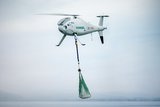BAMS radar flight testing underway
Northrop Grumman has announced that flight testing of the first developmental multifunction active sensor (MFAS) radar destined for the US Navy's MQ-4C Broad Area Maritime Surveillance Unmanned Aircraft System (BAMS UAS) has begun. The MFAS sensor has been integrated into the company's Gulfstream II testbed aircraft based in Palmdale, Calif., for flight testing after having completed ground station testing in late November at the company's Electronics Systems facility in Norwalk, Conn.
The company also reported that the first BAMS aircraft has received its wings and is standing on its own gear at the company's Palmdale manufacturing centre in California.
According to Northrop Grumman, over the next several months, testing of the MFAS radar will be broken down into three phases; radar integration, mode integration and refinement, and data collection. Each phase tests the various capabilities and modes of the radar that will be used by the Navy to provide a persistent common picture of the maritime surface traffic.
The MFAS sensor operates with a rotating sensor that incorporates electronic scanning and provides mode agility to switch between various surveillance methods. These include maritime-surface-search (MSS) mode for tracking maritime targets and inverse-synthetic-aperture radar (ISAR) mode for classifying ships. Image-while-scan capability is used to interleave very short duration ISAR functions (ISAR snapshot and high- range resolution) during MSS scans. Two synthetic aperture radar (SAR) modes are used for ground searches; spot SAR for images of the ground and stationary targets and strip SAR for images along a fixed line.
Once targets are detected by MFAS, the data is sent to ground station units in the form of tracks, single frame snap shots, as well as high resolution snapshots while still maintaining 360 degree coverage.
Currently, BAMS-D (demonstrator), a Block 10 RQ-4 version of the aircraft equipped with maritime sensors, is being used by the US Navy in the US Central Command area of responsibility, providing just a glimpse of the full persistent capabilities the MQ-4C MFAS radar will bring to the service's Maritime Patrol Reconnaissance Force.
More from Uncrewed Vehicles
-
Jammer resistant drone designs spark search for countermeasures
The Russia-Ukraine conflict has driven another stage of evolution for drones and the counter measures to defend against them.
-
![L3Harris launches Amorphous software for control of uncrewed platforms]()
L3Harris launches Amorphous software for control of uncrewed platforms
The new Amorphous software is a universal controller that would allow a single operator to control a swarm of “thousands” of uncrewed systems, from drones to underwater platforms.
-
ideaForge unveils new UAVs at Aero India 2025
India UAV supplier ideaForge has launched the Netra 5 and Switch V2 drones at Aero India 2025, boasting of enhanced endurance, AI-driven autonomy and improved operational capabilities.
-
![Shaping the future of defence: What 2025 holds for the global drone market]()
Shaping the future of defence: What 2025 holds for the global drone market
The UAV market is experiencing unprecedented growth, with innovations in technology and battlefield applications driving demand across military sectors. From the battlefields of Ukraine to NATO exercises and beyond, drones are transforming how wars are fought and supported.
-
![Maris-Tech confirms customers signing up for Jupiter Drones codec and AI-powered system]()
Maris-Tech confirms customers signing up for Jupiter Drones codec and AI-powered system
Launched at AUSA in October, the company’s multi-stream video codec is attempting to bring a new lease of life to drone technology through its AI accelerator.
-
![AUSA 2024: Quantum-Systems targets big 2025 with UAS developments]()
AUSA 2024: Quantum-Systems targets big 2025 with UAS developments
Quantum-Systems has been upgrading its UAS family, with new versions of the Vector, Reliant and Twister drones set for release throughout 2025.
























